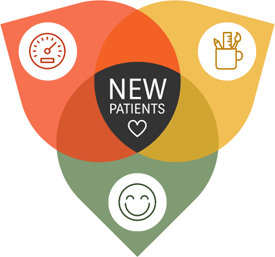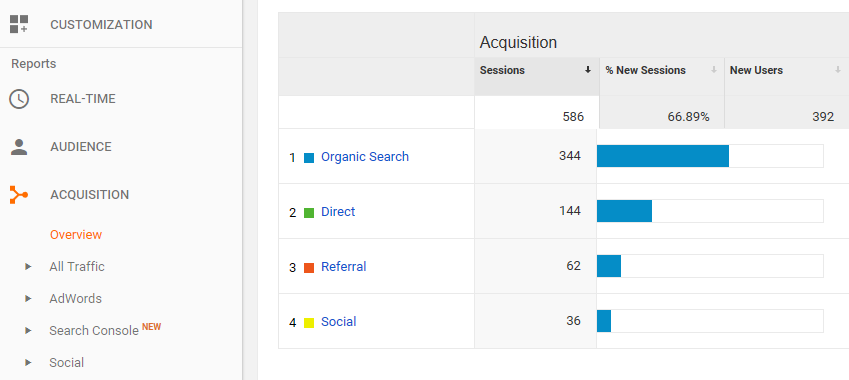Do you know how many people visit your website each month? Do you know how many of them actually book an appointment?
If you don’t have a way to measure your website’s performance, you have no idea whether it’s working.
Website traffic, demographics, behavioural trends, etc. – there are metrics you can analyse to identify where your website is succeeding and where it’s missing the mark.
Learn about Google Analytics and why taking advantage of this tool is critical to boosting your website’s new-patient-pulling power.
What is Google Analytics for Dentists?
By far the most-used web analytics software, Google Analytics delivers unparalleled access to your website’s performance. It’s a free tool that gives you insightful information about the people who visit your website and how they behave once they get there.
Most likely, you have current and prospective patients visiting your site every day. With Google Analytics, you can see how many visitors you attract in a given day, week, month, and year. But simply how many monthly visitors your website attracts is just a sliver of a much larger measurement – that is, the overall performance of your site.
From our experience managing 2300 practice websites, here are three high-level website stats we expect to see for a high-performing dental website:
- Organic Traffic: A good target is 300 to 500+ visitors per month. Organic traffic represents the “free” website listings on a Google search. In your Analytics account, click the “Acquisition” tab on the left sidebar menu. Then click “Overview” to see a breakdown of your traffic sources.
- Average Session Duration (Engagement): A good target is 2 to 3 minutes. Engagement is an SEO trend that is showing to be a stronger ranking factor. In your Analytics account, click the “Audience” tab on the left menu. Then click “Overview” to see a breakdown of the key engagement metrics (time on site, bounce rate, pages/session, etc.).
- Top Five Pages: The most important pages of any dental website are your homepage, dentist bio[s], contact page, about page, and services page. Our research dictates that these are the pages that most prospective patients want to see. In your Analytics account, click the “Behavior” tab on the left menu. Then click “Overview” to identify your top performing pages.
If the above stats are in order, then you’re site is in good shape.
If not, connect with your website administrator or digital marketing partner and direct them to deep dive into your site’s traffic (SEO), usability, and conversion methods. They’ll need to identify and execute essential actions to improve your site’s performance.
How to Interpret the Data
So what does it all mean?
Ultimately, these metrics illustrate everything that may be wrong (or right) about your website.
Have a high bounce rate? Low pages per visit? You’re either attracting irrelevant visitors or you’re attracting relevant visitors who are not interested in your content.
You can observe these metrics on a page-by-page basis, allowing you to identify underperforming pages and highlight any potential issues.
 For example, let’s say your homepage has attracted 300 visitors within the past 30 days. When looking at Google Analytics, you see the following metrics:
For example, let’s say your homepage has attracted 300 visitors within the past 30 days. When looking at Google Analytics, you see the following metrics:
- Bounce rate: 90 percent
- Average time on page: 30 seconds
- Pages per session: 1.1
Something’s not right. It’s apparent, you’re not hooking them.
There could be a number of reasons for this:
- Your website isn’t mobile-friendly. No doubt, a good portion of your visitors are accessing your site on mobile devices (most likely, well over half). People don’t have the patience to zoom in and out when viewing a website on their mobile device.
- Your content is lame. One of the leading culprits of poor website engagement is dull, uninspiring content. Don’t just describe what a root canal is. Tell prospective patients why they should choose you to perform the procedure.
- Your design is dated. The shelf life of a website is only three to five years. If your website has exceeded its shelf life, then you’re driving prospective patients straight to your competitors.
- Your navigation is messy. A clean menu and design layout is critical to keep visitors reading. A prospective patient is bound to “bounce” if they can’t immediately find what they’re looking for.
The Dental SEO Provider Pitch
When it comes to SEO, there’s a common consensus among most providers: “It’s all about where you rank on Google.”
The formula is simple:
Rankings + Traffic = New Patients
This is true, in theory. Ranking well in Google will bring in more website visitors. Getting more website visitors will produce new patients. If all the components are in place.
The “page-one rankings” moniker is a simplified overture used by sleazy SEO agencies just looking to tally another sale. Maybe you’ve seen the emails. Or you’ve heard the sales pitch: “We’ll get you ranking at the top of Google within the first 30 days!”
We’ve heard this countless times from Smile Marketing clients who, in the past, fell for the pitch.
First off, there are no guarantees in the SEO world. Such assurances are so prevalent that Google has even created guidelines to protect businesses from being duped. Straight from the horse’s mouth, this is what the search engine giant warns about the SEO industry:
- No one can guarantee a #1 ranking on Google.
- Be wary of SEO firms and web consultants or agencies that send you an email out of the blue.
- Be careful if a company is secretive or won't clearly explain what they intend to do.
- Be sure to understand where the money goes, particularly when online advertising is thrown into the mix.
Why does Google provide this warning? Because if they don’t result in new patients, rankings and traffic are meaningless markers.
While both are important, it’s about who you are attracting to your website and what they are doing once they land there. This means not just ranking, but ranking for the right keywords and having a website design that converts your ideal patients.
Here’s an experiment: Go to Google, type in “dandiest dentist,” and click on the first result.
You’ll see, ranking for meaningless keywords – something SEO providers do to make themselves look good – won’t translate into new patients.
The Number-One Metric…
Google Analytics has a vast arsenal of resources for identifying ways to improve your dental website’s performance.
 Still, it has one big limitation: It doesn’t track how many new patients your website produces.
Still, it has one big limitation: It doesn’t track how many new patients your website produces.
You can see how many people visited your services page. Or how many people made it to your contact page. What you don’t know is how many of them actually converted into appointments.
Why? Because this requires third-party software that integrates with your website. Smile Marketing’s analytics reporting does just that. Add a new patient to your website dashboard and you can see exactly where they came from – whether it’s Google, Facebook, or even a referral.
All in all, to optimise your website, you must first know how to measure it.
And Google Analytics is a great place to start.



